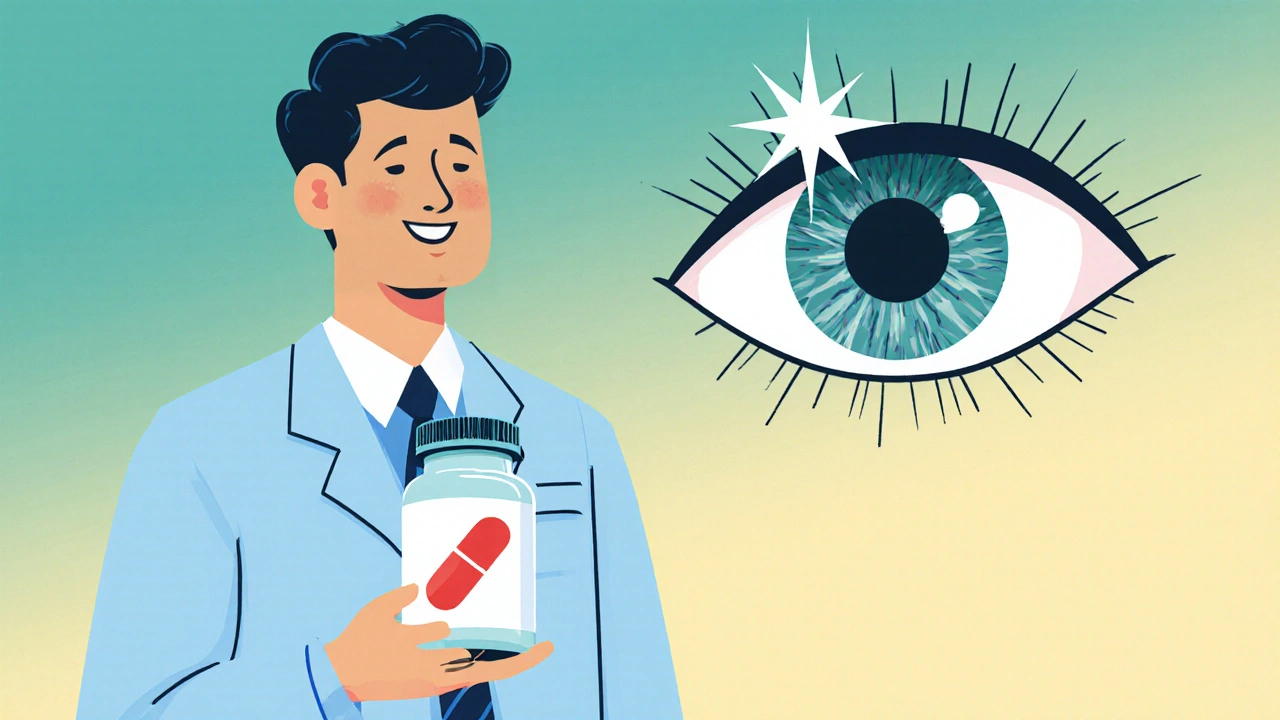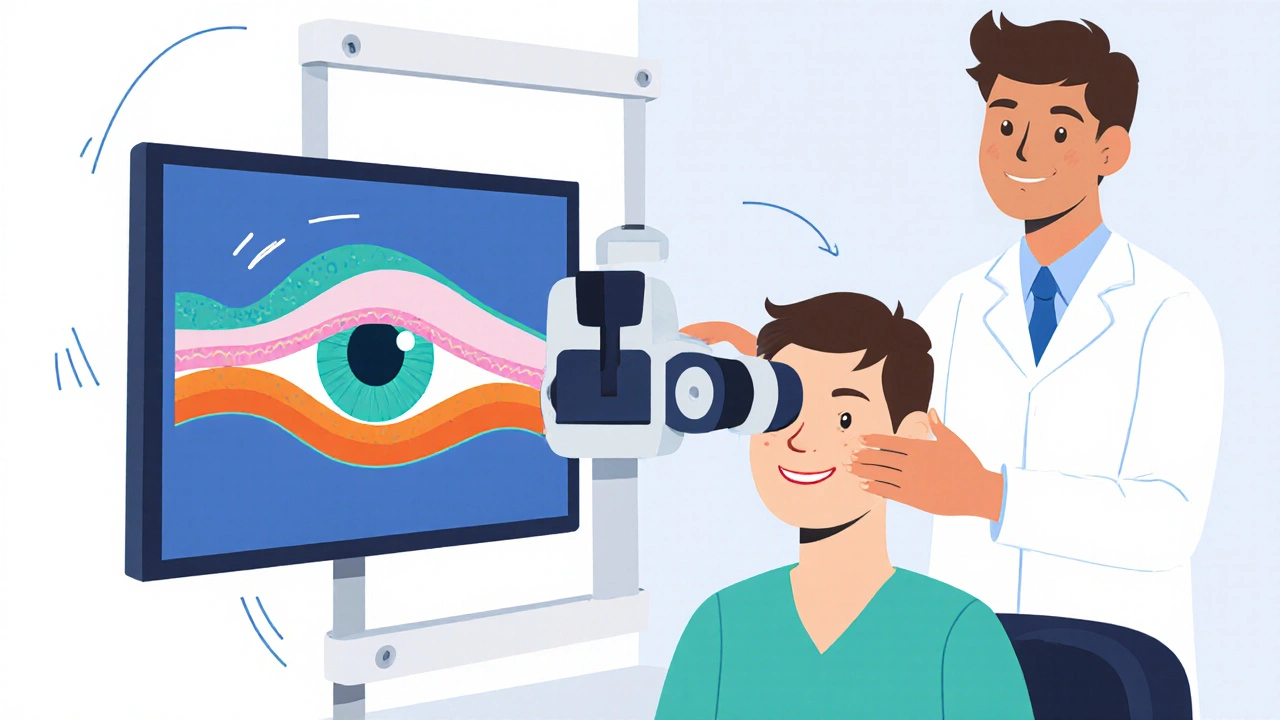Efavirenz and Eye Health: How to Protect Your Vision
 Oct, 17 2025
Oct, 17 2025
Efavirenz Eye Risk Calculator
This tool calculates your personal risk of ocular side effects while taking Efavirenz based on key factors mentioned in the article. Understanding your risk level helps determine appropriate monitoring and prevention strategies.
When you or a loved one is on Efavirenz is a non‑nucleoside reverse transcriptase inhibitor (NNRTI) that’s been a backbone of HIV treatment for decades. It helps keep the virus under control, but many patients wonder whether the drug can mess with their eyesight. The short answer: it can, but the risk is small and manageable if you know what to watch for and how to act.
What Is Efavirenz and Why Is It Used?
Efavirenz belongs to the class of drugs called NNRTIs. It blocks the reverse transcriptase enzyme that HIV needs to copy its genetic material. In most World Health Organization (WHO) recommended first‑line regimens, efavirenz is combined with two nucleoside reverse transcriptase inhibitors such as lamivudine and tenofovir. The combo keeps viral load low, protects CD4 counts, and reduces the chance of opportunistic infections.
How Efavirenz Can Affect Your Eyes
While efavirenz is praised for its potency, a handful of case reports have linked it to ocular problems. The most common issues are:
- Retinal toxicity - damage to the light‑sensing layer at the back of the eye.
- Maculopathy - thinning or discoloration of the macula, the part responsible for sharp central vision.
- Visual acuity changes - blurry or double vision that may come on gradually.
These effects are rare, estimated at less than 1% of users, but they matter because they can be irreversible if left unchecked.
Who Is Most at Risk?
Research points to a few risk factors that increase the odds of eye trouble while taking efavirenz:
- Genetic makeup: People with certain CYP2B6 polymorphisms metabolize efavirenz more slowly, leading to higher blood levels.
- Pre‑existing eye disease: If you already have diabetic retinopathy, age‑related macular degeneration, or high myopia, the drug’s impact can be amplified.
- Concurrent medications: Some drugs (e.g., protease inhibitors) raise efavirenz concentrations, while others (e.g., rifampicin) lower them, creating a balancing act for your doctor.
How Doctors Monitor Vision on Efavirenz
Standard HIV care includes regular blood work, but good eye care adds a few extra steps:
- Baseline eye exam: Before starting efavirenz, an ophthalmologist checks visual acuity, fundoscopy, and if available, Optical Coherence Tomography (OCT). OCT gives a cross‑sectional picture of the retina, making early changes easier to spot.
- Quarterly self‑checks: Patients are taught the simple “E” chart test at home - read the letters from a distance of 6m. Any dip in score should trigger a clinic visit.
- Annual comprehensive exam: A full dilated exam looks for subtle pigment changes or thinning of the retinal layers.

Practical Steps to Protect Your Vision
Even if you feel fine, a few habits can keep your eyes safe while on efavirenz:
- Stay on schedule: Take the pill exactly as prescribed. Skipping doses can cause spikes that stress the retina.
- Watch for early signs: New floaters, flashes of light, or a sudden loss of sharpness are red flags.
- Protect against UV: Sunglasses with UV‑400 protection reduce oxidative stress on retinal cells.
- Control systemic health: Keep blood sugar, blood pressure, and cholesterol in check - they all influence eye health.
- Report side effects promptly: If an eye issue pops up, your HIV care team can order an OCT and, if needed, switch you to a different NNRTI or an integrase inhibitor like dolutegravir.
When to Consider an Alternative Medication
If you develop confirmed retinal toxicity, most clinicians move you off efavirenz. Current guidelines from the U.S. Food and Drug Administration (FDA) and WHO list several alternatives with a cleaner ocular profile:
| Drug | Class | Reported Ocular Side Effects | Typical Use in First‑Line Regimens |
|---|---|---|---|
| Efavirenz | NNRTI | Retinal toxicity, maculopathy (rare) | Standard WHO first line (with TDF + 3TC) |
| Dolutegravir | Integrase inhibitor | Very low; isolated reports of blurred vision | Preferred WHO first line (2023 update) |
| Nevirapine | NNRTI | Rash, hepatotoxicity; no confirmed retinal issues | Older regimens, often replaced by efavirenz |
Switching is usually smooth; the new drug reaches steady state in about two weeks, and most patients see vision stabilize within a month.
What the Latest Research Says (2024‑2025)
A 2024 cohort study of 3,200 patients in South Africa found that only 12 individuals (0.37%) on efavirenz developed measurable macular thinning over five years. Those who carried the CYP2B6*6 allele were three times more likely to be affected. The authors concluded that genetic screening before starting the drug could cut the risk dramatically.
In contrast, a 2025 meta‑analysis of integrase inhibitors reported virtually no retinal events across 9,000 participants. This solidifies dolutegravir’s reputation as the eye‑friendly choice for new patients.
Quick Checklist for Patients on Efavirenz
- Get a baseline eye exam before the first dose.
- Perform a self‑vision test every three months.
- Wear UV‑blocking sunglasses daily.
- Maintain good control of diabetes, blood pressure, and cholesterol.
- Notify your healthcare team immediately if you notice floaters, flashes, or blurry vision.
- Ask about genetic testing for CYP2B6 if you have a family history of drug reactions.
Bottom Line
Efavirenz is an effective HIV weapon, and for most people it won’t mess with eyesight. Still, a tiny fraction does see eye changes, especially if they have certain genetic traits or pre‑existing retinal conditions. Regular eye checks, a few protective habits, and prompt communication with your care team keep the risk low. If problems arise, safer alternatives like dolutegravir are readily available.
Frequently Asked Questions
Can efavirenz cause permanent vision loss?
Permanent loss is rare. Most reported cases involve reversible changes in visual acuity or mild macular thinning that improve after stopping the drug. Early detection through OCT dramatically lowers the chance of lasting damage.
How often should I get an eye exam while on efavirenz?
A baseline exam before starting treatment, a self‑check every three months, and a full dilated exam at least once a year are the standard recommendations.
Is there a genetic test for efavirenz eye side effects?
Yes. Testing for the CYP2B6*6 allele can identify patients who metabolize efavirenz slowly, putting them at higher risk for both systemic and ocular toxicity.
What are the safer alternatives if I develop eye problems?
Dolutegravir is the most widely recommended alternative because it has virtually no reported retinal adverse events. Nevirapine is another NNRTI option, though it carries a higher risk of liver issues.
Do over‑the‑counter eye drops help protect my retina?
Standard lubricating drops can ease dryness but don’t shield the retina from drug‑related toxicity. UV‑blocking sunglasses and systemic health control are more effective.
Darryl Gates
October 17, 2025 AT 17:30Great rundown on the ocular risks of Efavirenz. Staying consistent with your dosing schedule is the first line of defense, as spikes in plasma levels can stress retinal cells. Pair that with quarterly self‑checks using an “E” chart, and you’ll catch subtle changes before they become permanent. Don’t forget UV‑400 sunglasses; they’re a cheap way to reduce oxidative stress on the retina. Keep your systemic health in check-blood sugar, blood pressure, and cholesterol all influence eye health.
Kevin Adams
October 26, 2025 AT 22:43The shadows of Efavirenz whisper and my eyes tremble at the thought!
Chris Beck
November 5, 2025 AT 04:56Efavirenz can hurt your eyes but not everyone gets it. If you have the CYP2B6 gene thing you’re more at risk. Keep an eye exam yearly, that’s all. No need to panic.
Sara Werb
November 14, 2025 AT 11:10Listen!!! The pharmaceutical giants don’t want you to know that Efavirenz is a silent assassin for your vision, especially if you’re a skeptic of mainstream medicine!!! They hide the data, they fund the studies, and they push the drug while the real cure is kept secret!!! Protect your eyes, question the narrative, and wear those UV shields like a shield against their deception!!!
Russell Abelido
November 19, 2025 AT 02:16I totally get the anxiety you’re feeling 😟. While it’s true that rare ocular side effects exist, the data show they occur in less than one percent of patients, and regular monitoring can catch them early. Remember, staying on schedule and getting that baseline eye exam are the most practical steps you can take.
Steve Holmes
November 26, 2025 AT 00:56Adding to the conversation, I’d suggest discussing with your clinician the possibility of a genetic test for the CYP2B6*6 allele. If you’re a carrier, your doctor might consider a lower dose or an alternative regimen such as dolutegravir. Also, keeping a log of any visual changes-floaters, flashes, or blurriness-can provide useful evidence during follow‑up visits.
genevieve gaudet
November 30, 2025 AT 16:03thats a smart move its like looking under the hood before you drive the car i mean you cant ignore the signs when they pop up and the gen test is a real eye opener it helps u and the doc make better calls
Michael Dalrymple
December 9, 2025 AT 22:16Efavirenz remains a cornerstone of first‑line antiretroviral therapy, yet clinicians must remain vigilant regarding its rare ocular toxicity. The pharmacokinetic profile of the drug indicates that individuals with reduced metabolic capacity may experience higher systemic exposure, which correlates with retinal stress. Recent cohort studies have quantified this risk at approximately 0.35 % over a five‑year horizon, underscoring its low but non‑negligible prevalence. Baseline ophthalmologic assessment, including optical coherence tomography, should be instituted prior to drug initiation. Quarterly self‑administered visual acuity tests serve as an early warning system, allowing patients to detect subtle declines without immediate clinical intervention. Annual dilated fundus examinations provide a comprehensive view of retinal integrity, facilitating the identification of pigmentary changes or macular thinning. In patients identified as carriers of the CYP2B6*6 polymorphism, dose adjustments or alternative agents such as dolutegravir are advisable. The modern therapeutic landscape offers integrase inhibitors with an essentially negligible ocular side‑effect profile, making them preferable for high‑risk individuals. Moreover, strict adherence to dosing schedules mitigates plasma spikes that could otherwise exacerbate retinal susceptibility. Systemic health optimization-particularly glycemic and blood pressure control-further reduces the cumulative burden on ocular tissues. Ultraviolet‑filtering eyewear should be recommended for all patients, as it attenuates oxidative stress that may synergize with drug‑induced toxicity. Patient education is paramount; individuals must be instructed to report any new visual phenomena, including floaters, photopsia, or decreased sharpness, without delay. Prompt referral to an ophthalmologist enables timely OCT imaging, which can reveal subclinical changes before functional loss becomes apparent. Should toxicity be confirmed, transition to an integrase‑based regimen generally results in stabilization of ocular findings within weeks. Finally, ongoing pharmacovigilance and reporting of ocular adverse events remain essential to refine risk stratification and guide future prescribing practices.
Katie Henry
December 16, 2025 AT 20:56Dear community, I commend the thorough discussion and encourage all patients to proactively schedule their baseline eye examinations. Commitment to regular monitoring will empower you to maintain optimal visual health while benefiting from effective HIV therapy.
Joanna Mensch
December 21, 2025 AT 12:03I’ve seen the hidden reports they don’t publish-small studies that hint at a larger problem. It’s unsettling that the narrative stays silent, but sharing this knowledge is the only way to stay safe.